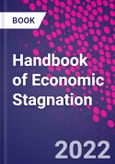Handbook of Economic Stagnation takes a broad view, including contributions from orthodox and heterodox economists who examine situations in countries and worldwide regions, including Japan and the Euro area. To be sure, stagnation is periodically relieved by short economic bursts usually brought on by unsustainable asset price bubbles. Once the bubbles burst, stagnation returns. This book's fresh, comprehensive approach to the topic makes it the premier source for anyone affected by these cycles.
Please Note: This is an On Demand product, delivery may take up to 11 working days after payment has been received.
Table of Contents
Part I: The Problem
1. Secular Stagnation: As Good as It Gets?
2. The US economy since the crisis: Slow recovery and secular stagnation
3. Understanding Secular Stagnation
4. Secular Demand Stagnation in the 21st Century U.S. Economy�.
5. Demand-led growth and accommodating supply
6. Demand Drives Growth all the Way
7. The 'Natural' Interest Rate and Secular Stagnation: Loanable Funds Macro Models Don't Fit Today's Institutions or Data
8. The New Normal: Demand, Secular Stagnation and the Vanishing Middle-Class
9. The Deep Causes of Secular Stagnation and the Rise of Populism�.�
10. A Comment on Servaas Storm's "The New Normal
11. The Secular Stagnation Hypothesis in the Theories of Growth: A Maze of Theoretical Inconsistencies
12. From Long-Term Growth to Secular Stagnation. A Theoretical Comparison Between Regulation Theory, Marxist Approaches and Present Mainstream Interpretations
13. Secular Stagnation: The History of a Macroeconomic Heresy�
Part II: Causes and Consequences
Role of Economic Policy
14. Secular Stagnation or Stagnation Policy? Steindl after Summers
15. There is no secular stagnation�- just irresponsible fiscal policy
16. The labor injunction and peonage
how changes in labor laws increased inequality during the Gilded Age
17. What the Federal Reserve Got Totally Wrong About Inflation?
Inequality
18. Income Shares, Secular Stagnation, and the Long-Run Distribution of Wealth�.
19. Varieties of Capitalism and Growth Regimes: The Role of Income Distribution�
20. Trends in US income inequality
21. Where Do Profits and Jobs Come From? Employment and Distribution in the US Economy
22. Secular stagnation and concentration of corporate power
Debt and Finance
23. Private Debt and Public Debility
24. Secular stagnation in the framework of rentier-financier capitalism and globalization�
25. The drivers of household indebtedness re-considered: An empirical evaluation of competing arguments on the macroeconomic determinants of household indebtedness in OECD countries
26. The Economics of Instability: An Abstract of an Excerpt
Supply Side Myth, Automation, and Future of Jobs
27. Age of Oversupply
28. Automation and the Future of Work
Part III: Macroeconomic Policy in Secular Stagnation
29. Can Trump Overcome Secular Stagnation?
30. Secular Stagnation and Progressive Economic Policy Alternatives
31. The Euro Area's Secular Stagnation and What Can Be Done About It. A Post-Keynesian Perspective
32. Core-Periphery Divergence and Secular Stagnation in the Eurozone: Macroeconomic Evidence and Policy Proposals Beyond Unconventional Monetary Policy
33. We Can Have a High-Wage America
34. Explaining, Restoring Low Productivity Growth in the UK
35. Public Sector Jobs as solution to Secular Stagnation
36. Green New Deal and Sustainable Economic Growth
37. Restructuring student debt








